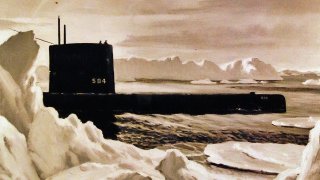Skate-Class: The U.S. Navy Nuclear Submarine That Broke All of the Rules
The Skate-Class was a reaction to the cost and size of the U.S. Navy's Nautilus-class submarine. Some would say she made too many compromises.
Naval warfare was revolutionized in the early 20th century with the advent of widespread submarine usage. German U-Boats carrying out unrestricted commerce warfare during the First World War heralded a new paradigm for navies around the world. These boats were continually improved through the interwar years, with the Second World War seeing even greater submarine usage by many countries, most notably the war waged by German U-boat wolfpacks in the North Atlantic against Allied shipping and the similar effort by American subs in the Pacific to degrade Japanese merchant capabilities.
Post-war, subs were now an integral part of fleet navies. The emerging technology of nuclear reactors promised to introduce a whole new range of capabilities for these craft, and the U.S. swiftly took advantage. While the USS Nautilus was the first nuclear-powered submarine constructed in 1955, her high cost caused policymakers to balk at acquiring more, at least for a short time. Instead, naval architects designed the Skate-class, the first ever production-model nuclear-powered submarines.
How The Skate-Class Was Born
The Skate-class was not designed in a vacuum. Instead, they sought to integrate nuclear propulsion into a proven vessel, the Tang-class submarines.
Operational lessons during the Second World War led to many changes and upgrades to fleet submarines as the conflict progressed. These were incorporated into the Tang-class vessels, the first designed by the U.S. Navy post-war. In addition, technology from captured German Type XXI U-boats proved revolutionary and was swiftly integrated into the design.
Lessons from fleet submarines gave the Tangs a better ballasting layout, which granted improved dive characteristics, more torpedoes, and greater fuel capacity for increased range. The Type XXIs were the first subs designed for extended underwater operations and thus prioritized subsurface speed and maneuverability. As such, they were much more hydrodynamic than their counterparts and changed the look of subs from surface ships, which simply slipped beneath the surface to escape detection to the sleeker shapes of the mid-20th century.
Introducing the Skate
Once the U.S. Navy realized the vast potential of nuclear-powered submarines with the successes of the USS Nautilus and Seawolf, planners swiftly sought to incorporate this technology into the fleet. The Nautilus had been an expensive endeavor and so for frontline boats the Navy instead proposed simply putting a scaled down reactor in a suitable hull, the Tang-class hull was chosen, with almost no external modifications made. This was prior to high submerged speed tests conducted by the Nautilus, so the Navy had yet to realize the desirability of that trait. As such, the Skates were similar in speed to the Tangs despite bearing a revolutionary power source.
In general, submarine designers have typically attempted to make their boats as small as possible. This serves the two-fold purposes of improved submerged maneuverability and reduced sonar cross-section, making them more difficult to locate. The Tangs and, subsequently, the Skates were smaller than the Nautilus; however, that made accommodating the nuclear reactor more challenging. The Skates were designed for the S3W reactor, a slightly smaller version of the S2W pressurized water reactor on the Nautilus.
In the case of reactors, smaller was not always better. The Navy hoped that the attempts to design a nuclear-powered aircraft would eventually yield smaller reactors fit for submarine use, however, the project was eventually abandoned. In the process of designing the S3W, the Navy realized that decreasing the size of a reactor did not result in a proportional decrease in the shielding which kept it safe and eventually accepted the need for larger power plants.
Skate-Class in Action
While Skates never saw combat, they did serve for several decades during the Cold War and achieved some notable successes, most particularly in Arctic Sea operations. On her second operational voyage, the USS Skate, lead boat in class, operated extensively in the arctic, surfacing several times through the ice. The following year, she returned to the Arctic and there became the first submarine to surface at the precise North Pole. She was awarded a Bronze Star for this voyage.
About the Author
Maya Carlin is an analyst with the Center for Security Policy and a former Anna Sobol Levy Fellow at IDC Herzliya in Israel. She has by-lines in many publications, including The National Interest, Jerusalem Post, and Times of Israel. You can follow her on Twitter: @MayaCarlin.


